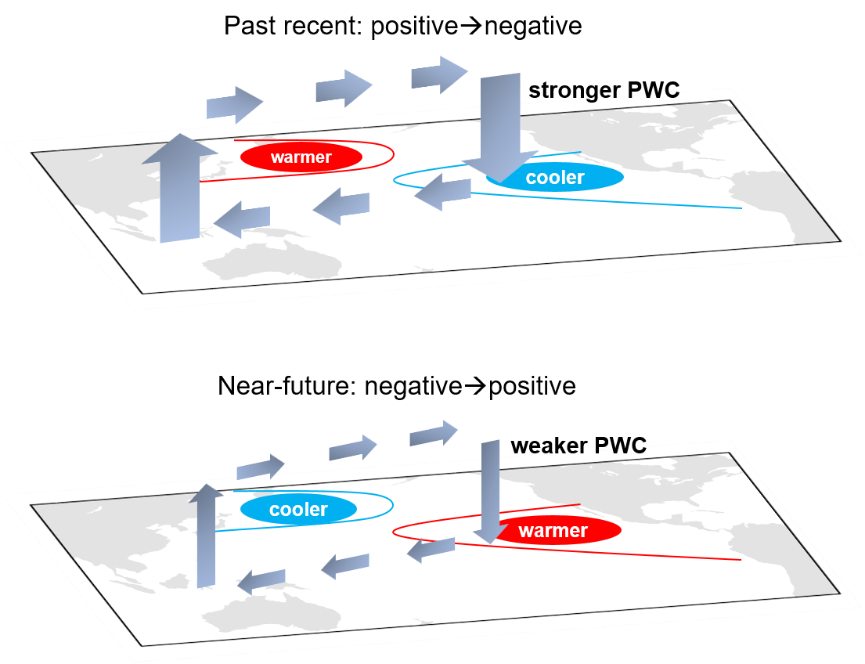A new study demonstrates that the naturally occurring warm-to-cold change in the tropical Pacific Ocean is the major cause for the recent intensification in Pacific Walker circulation, the most prominent feature of the tropical Pacific.
The Pacific Walker circulation, a large east–west atmospheric circulation along the equatorial Pacific, is observed strengthening during recent decades (1980–2015). The strength of Walker circulation can regulate the heat budget of the global climate system via air-sea interactions and has extensive impacts on water cycle over regions like the South Asia, the Maritime Continent and the Amazon basin. Identifying the driving mechanisms and hence predicting the future changes of the Walker circulation are essential for monitoring the hydrological cycle regionally and globally.
However, there is an ongoing debate on the physical driving mechanisms of the observed strengthening trend of the Walker circulation. A range of factors may have contributed to the observed changes of the Walker circulation, including external forcing and natural variability. The quantitative influence of these factors is still uncertain and which part of global ocean acts as a dominator remains inconclusive. Moreover, the potential change of the Walker circulation in the near-term future remains unknown.
Now a study by researchers at the Institute of Atmospheric Physics, Chinese Academy of Sciences, China, shows evidence that natural decadal variability related to the Pacific Ocean has played a more significant role in modulating the Pacific Walker circulation change and the Walker circulation is projected to weaken in the coming decades.
The study, which appears in Nature Communications online on 11th November, found that the phase transition from positive-to-negative of the ENSO-like fluctuations, known as the Interdecadal Pacific Oscillation (IPO), can explain 63% (~51-72%) of the observed PWC strengthening over the period of 1980-2015, according to ZHOU Tianjun, the corresponding author of the paper.
ZHOU is a senior scientist at the Institute of Atmospheric Physics in the Chinese Academy of Sciences. He is also a professor at the University of Chinese Academy of Sciences (UCAS).
"Based on the large ensemble simulations from six climate models, we quantified the contributions of external forcing and natural variability to the long-term change of the Pacific Walker circulation for the first time. We have identified the leading role of the Pacific Ocean in driving the decadal change of the Walker circulation and provided a constrained projection of its near-future change", said WU Mingna, the first author of the study, who is a Ph. D student from the UCAS.
"Large ensembles from a single climate model provide a powerful tool to address the roles of natural variabilities in attributing and projecting climate changes, it also provides a sufficient assemblage of independent samples to reveal the roles of different natural variabilities." says Chao LI, a climate modeler at the Max Planck Institute for Meteorology, Hamburg, Germany and co-author of the study.
"Looking into the future, the phase of IPO in the Pacific Ocean could last into the coming decades and the Walker circulation is likely to weaken if we use the IPO phase predicted by the most skillful ensemble members to constrain the PWC projection", added WU, "Consequently, the South Asia summer monsoon rainfall might be reduced, the northern part of the western Amazon is likely to experience a drier climate, and less rainfall is expected over large areas of the Maritime Continents".
These findings highlight an urgent need to improve the prediction of IPO and other decadal internal modes of climate variability.

Schematic illustrates the impact of Interdecadal Pacific Oscillation (IPO) phase transition on the strength of Pacific Walker circulation (PWC) in past recent and near-future. (Image by WU Mingna)
"Reliable predictions of the Walker circulation and associated climate and hydrological cycle change will provide useful information for climate change adaptation activities for policymakers and people who live in regions under the control of the Walker circulation", ZHOU highlighted.
###
This work is jointly supported by National Natural Science Foundation of China under Grant Nos. 41988101, 41605057, K. C. Wong Education Foundation, the Clusters of Excellence CLICCS (EXC2037), University of Hamburg, funded by the German Research Foundation (DFG), and National Key R&D Program of China under Grant 2020YFA0608904.
Reference
Wu, M., Zhou, T.*, Li, C., Li, H., Chen, X., Wu, B., Zhang, W., Zhang, L. A very likely weakening of Pacific Walker Circulation in constrained near-future projections. Nature Communications, (2021), https://doi.org/10.1038/s41467-021-26693-y.
Media contact: Ms. LIN Zheng, jennylin@mail.iap.ac.cn
